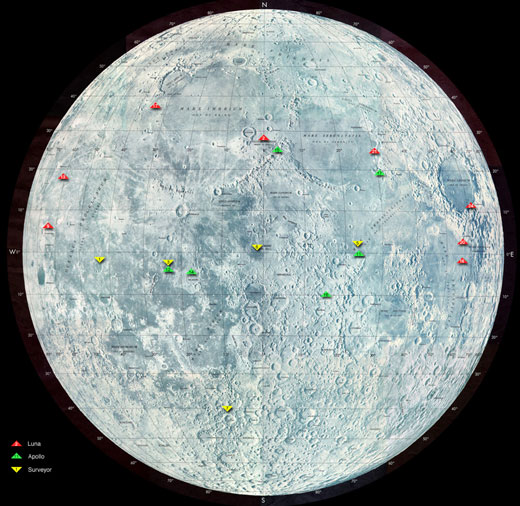Lunar Diary: a chronicle of Earth’s journey through space and time, as seen from the Moon Understand article
Clues to the history of the Earth, the Milky Way and the Universe are hidden on the lunar surface.
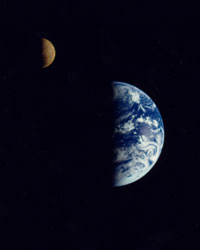
Galileo as it flew by the Earth
-Moon system in 1992.
Image courtesy of NASA
The Moon has been Earth’s constant companion for approximately 4.5 billion years. Together they have travelled around the Sun and the Milky Way galaxy. They formed together, have evolved together and experience a shared history. What makes the Moon so scientifically interesting is that, compared with Earth, it is a very simple place. It lacks the protective atmosphere of Earth, has no wind or rain, and its surface is not remodeled by tectonic activity. Because of this, the ancient surface of the Moon bears the marks and the chemical history of its journey alongside Earth and preserves evidence of the earliest geological history.
The Moon can tell us the story of the formation of the inner Solar System planets and is a diary of the journey of the Earth and Moon. It can tell us about the places our planet has been, and about the fellow travellers we have met along the way.
In this two-part series, I will first introduce why scientists wish to return to the Moon, what scientific questions remain and why it is important to find the answers. The second article (in the next issue) will focus on the challenges of returning to the Moon and obtaining these answers.
Humankind landed on the Moon six times between 1969 and 1972. In 1972, your students were not born, cell phones did not exist, computers were the size of a room, and the scientific knowledge and technical abilities were rudimentary compared to today. Science and technology have come very far since humans stood on the Moon, and lunar exploration is now approached differently.
Twelve men walked on the Moon during the six Apollo missionsw1. With them, they brought back 382 kg of lunar materialw2. The Soviet Union also had a very active lunar exploration program and although they did not send humans, they did send robots to the lunar surfacew3. Among a number of robotic surface missions, three Soviet Luna missions returned a total of 300 g of lunar materialw2,w4.
The samples from the Apollo missions are stored at a special facility in Houston, Texas, USA, while the Luna samples are stored at the Verndasky Institute in Russia. These samples are still studied by scientists to this day, and continue to produce new and unexpected scientific results.
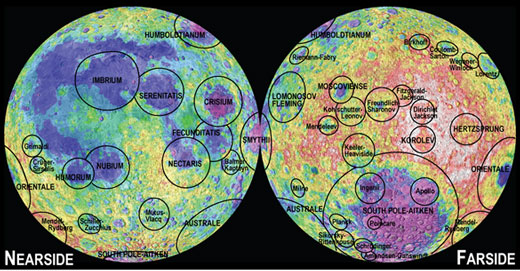
produced immense impact basins of more than 300 km in diameter. The colour-
coded topography ranges from 8 kilometers below a global mean (black to dark
purple) to 8 kilometers above a global mean (white). The largest and deepest
basin is the South Pole- Aitken Basin. The youngest and best preserved basin is
the Orientale Basin. This inventory of basins is based on Apollo-era analyses. New
efforts to detect other basins are underway.
Image courtesy of LPI (Paul Spudis and David Kring)
Although we have been to the Moon, we have barely scratched the surface in terms of exploring it or understanding what it has to tell us about ourselves. As aliens landing on a dune in the Sahara desert could never say they had explored or understood Africa, so is the extent of our exploration of the Moon today.
History of the Earth and Solar System
The formation of the Moon is still a matter of scientific debate. The leading scientific theory is that a large body called Theia slammed into Earth, destroying Theia and causing massive destruction of Earthw5. A large cloud of debris was ejected, and over time it collected together to form the Moon. However, there are inconsistencies in this model and computer simulations do not yield Earth and the Moon as we know them today.
Detailed chemical analysis of lunar samples from new locations would give scientists more information about the composition of the Moon and would expand our growing understanding of how the Moon was formed (see Herwartz et al., 2014, for evidence of Theia in lunar soil samples).
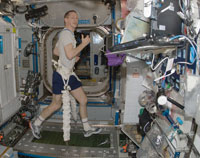
astronaut Frank De Winne,
Expedition 21 commander,
exercises on the Combined
Operational Load Bearing
External Resistance Treadmill
(COLBERT) in the Harmony
node of the International
Space Station.
Image courtesy of NASA
To establish the age of lunar samples, scientists rely on the analysis of the ratio of different parent-daughter isotopesw6. By extension, this method can also be used to identify the age of the specific terrains and craters from which the samples were takenw7. When scientists combine this information with the number of craters in a given terrain, they can estimate how many meteorite impacts have happened over time. From this information, the ages of cratered surfaces elsewhere on the Moon and throughout the inner Solar System can be inferred. As scientists learn more about the impact history of the Moon, more precise deductions can be made about the impact history of Earth that has been erased over time by our environment (e.g. by wind, rain and plate tectonics).
NASA’s Lunar Crater Observation and Sensing Satellite (LCROSS) Mission confirmed that there is water ice, as well as frozen gases (such as methane, ammonia, hydrogen gas, carbon dioxide and carbon monoxide) in permanently shadowed regions of the lunar polesw8. Lunar ice is a mixture of all the ice delivered to its surface during impacts, and analysis of this ice could be useful in understanding the origins of water on Earth. In addition, lunar ice is thought to be a trap and a good place to look for frozen gases and reactions that may have formed pre-biotic chemistry. Some theories suggest that the early precursors of life on Earth may have been delivered by or formed during icy impactsw9, so the analysis of the lunar ice could also help researchers to understand the very early origins of life on Earth.
Travel beyond the Moon and into space
The Moon can also be used as a testing location for missions to Mars and other planetary bodies. Much has been learned in remote environments on Earth and in the International Space Station (ISS) but the Moon represents a greater level of difficulty than what has been previously achieved. Mars will be an even bigger challenge than the Moon; any challenges must first be overcome on the Moon, which is closer to Earth, before we can hope to succeed on other distant planetary bodies. The Moon can be the testing grounds for:
- building a base on another planet. We can use the experience from remote bases such as Arctic and Antarctica research stations, but there is much to learn about building a habitat off our planet. To explore this further with your students, please refer to a lesson on space habitatsw10.
- developing and implementing procedures to use the natural resources on the lunar surface to reduce what must be brought from Earth (known as in situ resource utilisation (ISRU)). Local resources could supply material needed for building habitats, shielding astronauts from radiation, supplying raw material for life-support systems and even for fuel for planetary exploration. Their use is actively being tested by space agenciesw11 and this work will feed knowledge to the lunar and planetary missions.
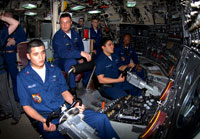
guided-missile submarine,
USS Florida (SSGN-728), in
March 2010
Image in the public domain/
Wikimedia commons
- dealing with health and equipment hazards such as radiation and lunar dust. Experience from industries such as nuclear power plants and mining will help us, but would need to be adapted before being implemented on the lunar surface. Water is believed to be a good radiation shield, but how do we get water on the Moon? It is too heavy to carry there in large quantities, so it would need to be harvested or made on the Moon.
- operating missions with limited food and water – submarine, polar and ISS missions can help inform us, and efforts should be made to grow food on the Moon.
- equipping a habitat with the right tools – submarine, polar and ISS missions can help us create equipment lists, and a workshop on the Moon may be needed to build and repair small pieces of equipment. Furthermore, three levels of redundancy must be built in for life-support equipment to ensure astronaut safety.
- dealing with medical emergencies far from medical personnel – submarine, polar and ISS missions have taught us a lot, but questions remain about treating infections, dealing with minor surgeries or even a sore tooth. A partial solution could be to have a doctor as part of the crew.
-
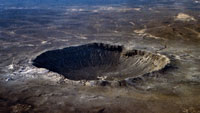
Barringer Meteor Crater in
Arizona, USA
Image in the public domain,
courtesy of the U.S. Geological
Surveystudying the psychology of living in an extreme environment away from family, friends and modern conveniences. Much has been learned from isolated missions, but there are discussions of how to realistically test this psychological stress. Simulation participants know it is just a simulation and it will end. How will people feel watching Earth shrink into a tiny speck as they spend months travelling in a tiny capsule to Mars? There may not be a way to accurately simulate such an experience.
The Moon could also become a staging post for planetary exploration. Lunar resources could be used to generate fuel and consumables such as oxygen. The base on the Moon could become a collecting point for Earth resources and Moon-made resources from which missions to other planets could be prepared. The reduced lunar gravity makes launching planetary exploration missions from the lunar surface much less energy-demanding when compared to launches from Earth. Desert and polar missions can be used as a test location, but the best place to test this is on the Moon.
There are many scientific and exploration reasons to return to the Moon. In the next decade, many different space agencies, countries and the private sector have planned robotic missions. The next challenge is to determine how we get there and how we return samples and knowledge. Stay tuned to the next issue of Science in School for some ideas.
Acknowledgements
Thank you to James Carpenter at the European Space Agency for valuable feedback on the article.
References
- Herwartz D, Pack A, Friedrichs B, Bischoff A (2014) A study reporting isotopic traces of Theia: Identification of the giant impactor Theia in lunar rocks. Science344(6188): 1146-1150
Web References
- w1 – Check the NASA website for a brief overview of the Apollo programme and its missions to Mars.
- w2 – Find out what happened to the lunar samples brought back by the Apollo missions.
- w3 – Compare the goals of the various missions sent to, or around, the Moon.
- w4 – The Lunar and Planetary Institute (LPI) of the Universities Space Research Association provides a summary of the Luna missions launched by the Soviet Union.
- w5 – In an article entitled ‘How did the Moon form?’, a short video explains one possible theory.
- w6 – Learn more about parent-daughter isotopes.
- w7 – Check the LPI website for more information about the impact craters on the Moon and what we can learn from them.
- w8 – Read more about LCROSS from the NASA website.
- w9 – Read an article that explains how the origin of life on Earth has been linked to impacts of ice comets.
- w10 – Want to build a space habitat in your classroom? Check out this article from a previous issue:
- Tranfield E ( 2011) Building a space habitat in the classroom. Science in School 19: 43-49.
- w11 – Read more about NASA’s effort to develop In-situ Resource Utilisation procedures.
Resources
- For more information on how astronomers estimate the age of Mars by crater counting, see this article from a previous issue:
- de Pablo MA, Centeno JD (2014) Glaciers on Mars: looking for the ice. Science in School 28: 12-17.
- In ‘Ice on the Moon’, NASA researchers explain the origin of ice on the moon and why it is so interesting.
Review
This article (part 1 of 2) gives an overview of how the Moon has formed, our visits to the Moon’s surface, and their scientific benefits. When travelling into space, e.g. to Mars and beyond, the Moon seems to be an important testing area for the preparation of the journeys – some of these challenges are summarised in the article and will be discussed in part 2.
This article would be useful not only for physics, but also for geography, different languages and biology.
Comprehension questions could include:
- How was the Moon formed?
- Why did humankind visit the Moon? How often have they visited, and which nationalities were involved?
- What are the differences between the Moon’s surface and atmosphere and Earth’s?
- Why could the Moon become important for further planetary explorations?
Gerd Vogt, Higher Secondary School for Environment and Economics, Yspertal, Austria






